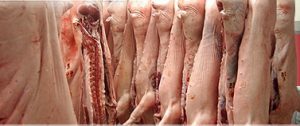Meat & Meat processing
As meat products are processed within chilled premises, the subsequent high relative humidity creates ideal conditions for bacterial growth. Dripping condensation and wet surfaces are another potential source of food contamination.
Under new EU legislation, stricter hygiene standards now include compulsory monitoring and recording of humidity levels in food warehouses, processing plants and coldstores.
‘Water Activity’ is used as a measurement of moisture at the surface of food products. Multplying the water activity by 100 gives the RH of the atmosphere in equilibrium with the food.
Since yeast, moulds and bacteria require a certain amount of available moisture to support growth, maintaining a water activity of 0.7 (70% relative humidity) can provide effective control.

Growth of the following harmful micro-organisms are generally inhibited below a water activity of 0.7:-
Pseudomonas, escherichia, proteus, shigella, klebsiella, bacillus, clostridium perfringens, listeria, salmonella, vibrio parahaemolyticus, C. botulinum, serratia, lactobacillus, pediococcus, rhodotorula, pichia, candida, torulopsis, hansenula, micrococcus, staphylococcus aureus, debaryomyces, mycotoxigenic aspergilli, most saccharomyces (baillii), most moulds (mycotoxigenic penicillia) and most halophilic bacteria.
